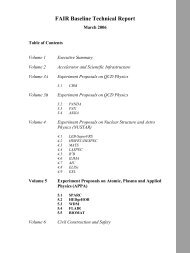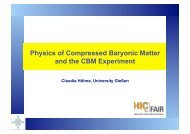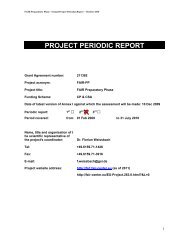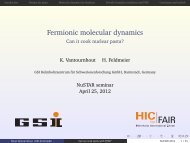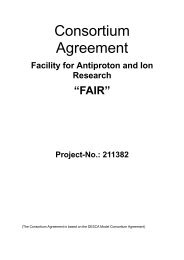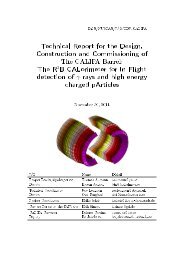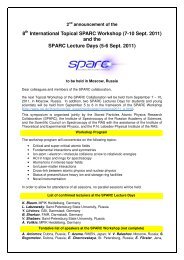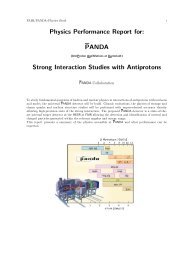NeuLAND - FAIR
NeuLAND - FAIR
NeuLAND - FAIR
You also want an ePaper? Increase the reach of your titles
YUMPU automatically turns print PDFs into web optimized ePapers that Google loves.
e studied at R 3 B at <strong>FAIR</strong> include nuclei which are produced in explosive astrophysical<br />
scenarios where the heavy elements are synthesized in the r-process. While ground-state<br />
properties like masses and half-lives are the most important properties necessary for<br />
modeling the rapid neutron capture process in an equilibrium stage, it has been shown<br />
that for an accurate theoretical description of the r-process the dipole response of these<br />
nuclei plays an essential role in determining the final abundance of nuclei as observed<br />
in the solar system. A systematic change of the response of nuclei alters the result of<br />
the elemental synthesis significantly [Gor-98], [Rau-08]. An experimental and theoretical<br />
effort has to be undertaken in order to understand the response of these neutron-rich<br />
nuclei. Since the neutron separation energies for these nuclei are typically approximately<br />
one to two MeV only, the decay of excited projectiles involves many neutrons. In order<br />
to enable an invariant-mass analysis, the momentum vectors of the different neutrons<br />
have to be resolved. Typically around four neutrons from the decay of the GDR will<br />
have to be detected. <strong>NeuLAND</strong> will be the first detector which will be capable to satisfy<br />
such a demand. An efficiency for a correct detection of a four-neutron event of about<br />
60% is envisaged.<br />
2.2. Dipole Strength at the Particle Threshold<br />
Electromagnetic excitation of exotic nuclei is of importance as well from an astrophysical<br />
point of view as mentioned already in the previous section. While the paths of the nucleosynthesis<br />
processes like the r-, and rp-processes are essentially determined by nuclear<br />
masses and lifetimes, the final abundance patterns depend also on the (p,γ) and (n,γ)<br />
reaction rates. For the modeling of astrophysical processes with network calculations,<br />
the reaction rates are usually calculated using a standard dipole response of nuclei as an<br />
input to a Hauser-Feshbach calculation. It has been shown by Litvinova et al. [Lit-09]<br />
that for a microscopically calculated dipole response (which predicts a significant shift<br />
of strength towards lower excitation energies for neutron-rich nuclei) used as input, the<br />
capture cross sections in the astrophysical temperature range change significantly, and<br />
the final abundances as a consequence as well. Beside a fundamental understanding of<br />
the dipole response and its decay patterns, a direct measurement of critical capture cross<br />
sections is needed [Sur-09]. The heavy-ion induced electromagnetic excitation process<br />
enables a measurement of the inverse process, i.e., the Coulomb breakup into fragment<br />
and proton or neutron. The capture cross section or astrophysical S-factor can then<br />
be deduced by using the detailed balance theorem. Prominent examples from previous<br />
studies are the S-factor for the 7 Be proton capture [Sch-03], [Sch-06], the 14 C neutron<br />
capture studied in 15 C Coulomb breakup [Dat-03], or the breakup of 7 Li [Ham-10].<br />
The energy region where the cross section is needed is determined by the relevant temperatures<br />
in the astrophysical processes. Usually, this corresponds to an energy window<br />
around or even below 100 keV. For the measurement of the inverse process, this translates<br />
into low relative kinetic energies between fragment and neutron in the CM system<br />
after excitation. The excitation and detection process takes advantage of the high beam<br />
21





